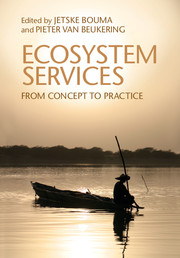Book contents
- Frontmatter
- Contents
- About the authors
- Part I Introduction
- Part II Measuring ecosystem services
- 2 The role of biodiversity in the provision of ecosystem services
- 3 A traits-based approach to quantifying ecosystem services
- 4 Mapping ecosystem services
- Part III Valuing ecosystem services
- Part IV Paying for ecosystem services
- Part V Governing ecosystem services
- Index
- Plate section
- References
3 - A traits-based approach to quantifying ecosystem services
from Part II - Measuring ecosystem services
Published online by Cambridge University Press: 05 February 2015
- Frontmatter
- Contents
- About the authors
- Part I Introduction
- Part II Measuring ecosystem services
- 2 The role of biodiversity in the provision of ecosystem services
- 3 A traits-based approach to quantifying ecosystem services
- 4 Mapping ecosystem services
- Part III Valuing ecosystem services
- Part IV Paying for ecosystem services
- Part V Governing ecosystem services
- Index
- Plate section
- References
Summary
Introduction
Ecosystem services for the benefit of people are to a large extent determined by the functioning of the ecosystems involved. When taking the classification of the MEA (2005), it is apparent that provisioning services, such as food and water supply, are directly related to quantities (of energy, water, and other substances) and quality (e.g. food quality or drinking water quality) delivered by ecosystems. Also supporting services, such as nutrient cycling, directly relate to quantity and quality of particular ecosystem processes (de Bello et al., 2010). To a lesser extent, this is also true for regulating services such as flood or fire control and cultural services. These latter two categories might be more directly related to the stability and biodiversity of ecosystems (as described in Chapter 2 of this book); see Figure 3.1.
So, in order to predict and quantify provisioning and supporting services, we need to understand the quantity and quality of products delivered by ecosystems. In other words, we need to understand how ecosystems function. While most of the literature on the valuation of ecosystem services so far has mainly focused on the quantities delivered by ecosystems, we will show in this chapter that quantity and quality are intimately linked through the properties of the species living in the ecosystems and their behavior.
Information
- Type
- Chapter
- Information
- Ecosystem ServicesFrom Concept to Practice, pp. 40 - 64Publisher: Cambridge University PressPrint publication year: 2015
References
Accessibility standard: Unknown
Why this information is here
This section outlines the accessibility features of this content - including support for screen readers, full keyboard navigation and high-contrast display options. This may not be relevant for you.Accessibility Information
- 1
- Cited by
